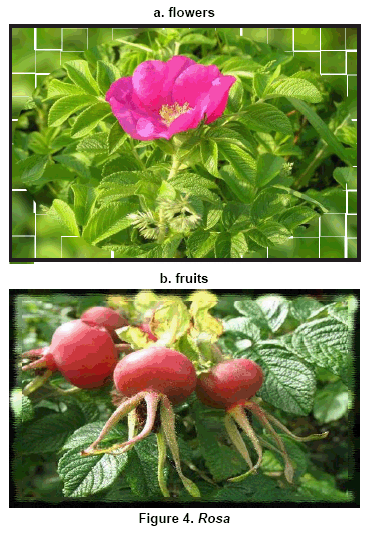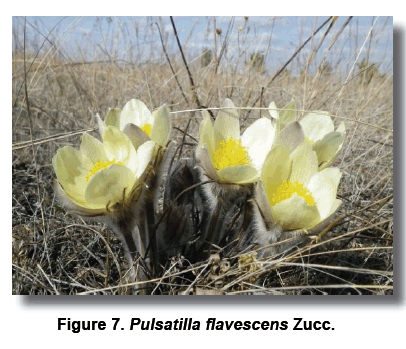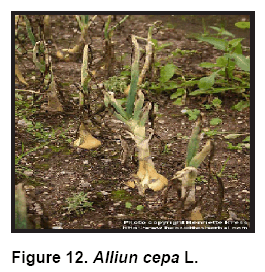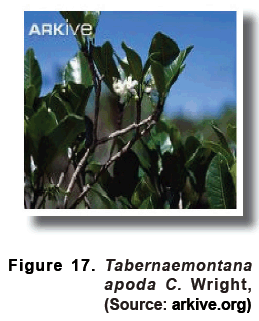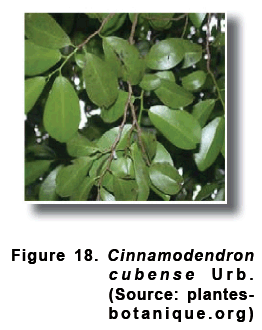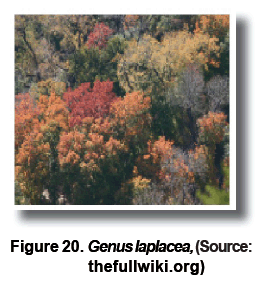Mi SciELO
Servicios Personalizados
Revista
Articulo
Indicadores
-
 Citado por SciELO
Citado por SciELO
Links relacionados
-
 Similares en
SciELO
Similares en
SciELO
Compartir
Cultivos Tropicales
versión impresa ISSN 0258-5936
cultrop vol.35 no.3 La Habana jul.-set. 2014
REVIEW
Medicinal herbs, great potential and endangered problems in Asia (Kazakhstan), Africa (Egypt) and America (Cuba)
Plantas medicinales, gran potencial y problemas de extinción en Asia (Kazajstán), África (Egipto) y América (Cuba)
PhD. Sandra Pérez Álvarez,I PhD. Luis E. Cossio Vargas,I PhD. Daniel Cabezas Montero,II PhD. Stikhareva Tamara Nikolayevna,III PhD. Kirillov Vitaliy Yurevich,III PhD. Kazangapova Nurgul Burkitbayevna,III PhD. Chebotko Nadezhda Konstantinovna,III PhD. Yasser A. H. OsmanIV, PhD. Ahmed I. S. AhmedIV
INational Research Institute of Foresty, Agriculture and livestock (INIFAP)-Experimental Campus Uruapan, ave: Latinoamericana No. 1101, Col. Revolución, Uruapan, Michoacán, México.
IIAgrarian University of Havana, carretera Tapaste, km 22 ½, San José de las Lajas, Mayebeque, Cuba.
IIIKazakh Scientific Research Institute of Forestry, 58 Kirov str., Town of Shchuchinsk, Akmola Region, Kazakhstan, 021704.
IVAhmed, Medicinal and Aromatic plants production Unit, Medicinal and Aromatic plants Dept., Desert Research Center, Cairo, Egypt.
ABSTRACT
The damage that world biodiversity is facing this days and their negative impact in the obtainment of new molecule of therapeutic interest is a sad reality, because there are species that have been disappear from this planet. The aim of this review is to analyze the great potential and endangered problems of some medicinal plants in three countries as a representation of three continents of our planet. Analysis of flora of some herbaceous plants in Kazakhstan has shown that about 40 % of sorts presented in its composition have economic importance. In Egypt up to 95 % of its lands are deserts. One of the most valuable treasures that can be found in those deserts are Medicinal and Aromatic plants where is possible to find 30 economically cultivated species. In Cuba medicinal plant species amount to 1 241 (97 are endemic ones), which belong to 725 genera from 172 families. Among them, 17 species, which have the same quantity of genera and families, are in the endangered categories and from them 4 are critically endangered. Medicinal herbs are taking their place alongside the likes of bioenergy crops, sources of renewable industrial feed stocks and bioremedials as potential beneficiaries of technological solutions. For this reasons scientific community most pay attention to this important source of plants especially to those that are endangered.
Key words: medicinal plants, biodiversity, Kazakhstan, Egypt, Cuba.
RESUMEN
Los daños que la biodiversidad mundial sufre actualmente y su impacto negativo en la obtención de nuevas moléculas de interés terapéutico es una triste realidad, porque hay especies que han desaparecido del planeta. El objetivo de esta revisión es analizar el gran potencial y problemas de extinción de algunas plantas medicinales en tres países diferentes como una representación de tres continentes de nuestro planeta. El análisis de la flora de algunas plantas herbáceas en Kazajstán mostró que alrededor del 40 % de las especies presentes tienen importancia económica. En Egipto el 95 % de sus tierras son desiertos. Uno de los tesoros más valiosos que puede encontrarse en esos desiertos son las plantas Medicinales y Aromáticas donde es posible hallar 30 especies económicamente cultivadas. En Cuba la cantidad de plantas medicinales es de 1 241 (97 son endémicas), las que pertenecen a 725 géneros de 172 familias. Entre estas plantas, 17 especies, las cuales tienen la misma cantidad de género y familia, están en la categoría de amenazadas, y de estas 4 están críticamente en peligro. Las plantas medicinales están tomando su lugar junto a los cultivos bioenergéticos, fuente de energía renovable para las industrias y bioremediales como beneficiarios potenciales de soluciones tecnológicas. Por estas razones la comunidad científica debe prestar atención a esta importante fuente de plantas especialmente a aquellas que se encuentran amenazadas.
Palabras clave: plantas medicinales, biodiversidad, Kazajstán, Egipto, Cuba.
INTRODUCTION
Medicinal plants are one of most valuable groups, attracting attention of specialists in different scientific directions. The number of chemical agents derivable from plants is growing and it opens new groups of combinations. However, popularity of medicinal herbs does not fall, but quite the contrary, continues to grow. In spite of enormous achievements of chemistry and production of large quantity of synthetic preparations, medicinal herbs are of great importance, and amounts of their stocking up grow steadily (1).
The use of traditional medicine and medicinal plants in most developing countries, as a normative basis for the maintenance of good health, has been widely observed (2) Furthermore, an increasing reliance on the use of medicinal plants in the industrialized societies has been traced to the extraction and development of several drugs and chemotherapeutics from these plants as well as from traditionally used rural herbal remedies (2). Moreover, in these societies, herbal remedies have become more popular in the treatment of minor ailments, and also on account of the increasing costs of personal health maintenance. Indeed, the market and public demand has been so great that there is a great risk that many medicinal plants today, face either extinction or loss of genetic diversity.
Genetic biodiversity of traditional medicinal herbs and plants is continuously under the threat of extinction as a result of growth-exploitation, environment-unfriendly harvesting techniques, and loss of growth habitats and unmonitored trade of medicinal plants (3).
The sustainable use of natural resources is a worldwide concern, and Kazakhstan, Egypt and Cuba are not exception.
In Kazakhstan many sorts are recognized by state pharmacopeia and used in official medicine. However quantitative indices of separate sorts vary greatly, besides among them there are rare sorts requiring protection. So, for practical use it is possible to recommend only small quantity of all the sorts sprouting in the region.
In Egypt Medicinal and aromatic plants (MAP) are playing an important role in many fields, including pharmaceuticals, cosmetics, production of spices, natural pesticides closely linked to public health issues, food for both human and animals. As early as 3000 B.C., the ancient Egyptians put much confidence in plants for curing their diseases. Up till now, the same confidence still exists among contemporary Egyptians and a “turn back” to “remedy by herbs” is now becoming global rather than regional or national request. Till now no limit for exportation value where rate of exportation of medicinal and aromatic plants in Egypt if follow international standers for production of MAP (4, 5, 6).
In the island of Cuba natural disasters in form of almost yearly hurricanes and lack of products on the markets leading to a reliance on the local natural resources, create a heavy pressure on the Cuban biodiversity (7). The need for research on Cuban floral biodiversity and the use of Cuban natural resources and public information about endangered plants in Cuba is therefore of great importance.
The aim of this review is to analyze the great potential and endangered problems of some medicinal plants in three countries as a representation of three continents of our planet.
Kazakhstan
Medicinal Plants with Great Potential
The given species of herbs are chosen for this paper because they solved the official pharmacopoeia not only in Kazakhstan but also in the countries of the Commonwealth of Independent States. Their beneficial properties are studied deeply and it has practical use for a long time, also these species of plants are reducing their magnitude due to increased anthropogenic impact, and the reduction of natural habitat, thanks to massive indiscriminate charges for their decorative or other useful properties (8).
- Yarrow (Achillea millefolium L.) (Figure 1) – is found on clearings, glades and in pine forest of fresh types of site conditions with the stock of overground phytomass from 4 kg.ha-1 in pine forest to 38 kg.ha-1 on clearings, but in places of the largest concentration - to 497 kg.ha-1. The herb is used in official pharmacopeia as antiphlogistic, wound healing and styptic agents.
- Green strawberry (Fragaria viridis Duch.) (Figure 2) - sprouts, basically, on forest clearings of fresh and dry types, where the stock of overground phytomass reaches 260 kg.ha-1. Fruit is a valuable raw material; however, herb is used in folk medicine.
- Wild strawberry (Fragaria vesca L.) (Figure 3) is found, mainly, in fresh and dry pine and birch forest, where the stock of phytomass of leaves reaches 66 kg.ha-1 in birch forest and 17 kg.ha-1 in fresh pine forest. Fruit is used in official medicine as diuretic, diaphoretic and as the substance improving the functioning of the gastrointestinal tract; leaves are used in folk medicine.
- Dog-rose (Rosa canina L.) (Figure 4) - it is rather an abundant sort in undergrowth of pine and birch forests, productivity of its fruit reaches 12-15 kg.ha-1 even in weakly fruitful years, 30 % - at a protective covering of the sort. The fruit of the dog-rose is used in official medicine with the purpose of preventive measures and treatment of hypovitaminosis of ascorbic acid and of rutin.
- Creeping thyme (Thymus serpyllum L.) (Figure 5) – is found, mainly, on clearings and glades in dry site conditions, where its stock can vary from 46 to 150 kg.ha-1, rarely it can be found under the canopy of dry and very dry pine forest. The herb of the given plant is widely used in official pharmacopeia as antiphlogistic and bactericidal substance.
Among the sorts of medicinal herbs found in the region there are those, the number of which are extremely small and they require protection. First of all, these are Adonis vernalis, Vaccinium vitisidaea L., Valeriana officinalis L., Oxycoccus palustris Pers., Nuphar lutea L. and others.
A number of plants are used in official medicine the following types can be found in abundance in the region:
- Antennaria dioica (Figure 6) reaches its maximum development in dry and in very dry pine forest, where its stock forms 22-80 kg.ha-1. This herb is used in official medicine as cholagogue substance.
- Pulsatilla flavescens Zucc. (Figure 7) sprouts on glades and clearings in dry conditions, its stock reaches 82-150 kg.ha-1, as well as in dry pine forest and in thinned fresh pine forest, where its stock is considerably lower. The herb of this plant is used for treatment of dynamic diseases of the nervous system, of locomotorium, of upper respiratory tract.
The use of plants as medicinal raw material must be rational, in accordance with nature protection principles. So, alongside with the revealing of biological resource, it is necessary to determine the reserve which will be used. By biological resource we mean the amount of raw material which is possible to store up on the area of the plot assigned for stocking up without taking into account the necessity of regeneration of populations of medicinal herbs; by the reserve we mean the amount of raw material which is possible to store up on the same area, but on condition of conservation of a part of species, providing normal renewal of the sort and regeneration of populations (1).
Ex situ collections allow saving wild species, examining them in cultural environment, and giving necessary recommendations to regulate the collection of plant raw materials in nature. At the same time a number of medicinal crops such as Helichrysum arenarium (L.) Moench., Plantago major L., Rosa majalis Herrm, Adonis vernalis L., Valeriana offisinalis L. will require plantation cultivation to meet the needs of pharmaceutical base development. Saving and restoration of natural ecosystems is only possible when given a reasonable management based on scientific and legal bases. People should not forget the importance of genetic resources conservation not only for biological diversity and ecological balance, but also for their use in practical breeding (8).
Some Medicinal Plants endangered
According to the Decree of the Government of Republic of Kazakhstan of October 30, 2006 «List of rare and endangered species of plants» 387 species, including 363 – Division of Magnoliaphyta, are protected. The most impressive are the following species – Tulipa, Stipa, Allium, Jurinea, Ferula, Oxytropis, Astragalus, Adonis and some others (9).
In this country there are over 6 000 species of plants, of which one tenth belongs to the endangered species, more than 120 species are wild relatives of agricultural plants, 70 species of 29 genera are forage crops, more than 700 species of medicinal plants are mentioned in folk medicine and 263 plants - in the scientific (8).
Expeditionary examination showed the present state of natural vegetation funds considering a significant change in species composition in natural cenoses, reduction the area of medicinal plants and decreases the wild stocks of raw materials (8).
The system of conservation of biodiversity of flora and vegetation in Republic of Kazakhstan is through the creation of protected areas – national natural reserves, national parks, state natural reserves, and some others. The total area specially protected is currently 5678.7 thousand hectares, which include 10 state nature reserves-1612.0 thousand hectares; 11 State national natural parks–2249.3 thousand hectares; four State natural reserve–1817.4 thousand hectares (10).
Egypt
Medicinal Plants with Great Potential
Egypt flora includes more than 2000 plant species. Moreover 500 are useful or potential use for medical purposes.
It also includes 13 pharmacopeia ones, 60 endemic ones and 529 species use for medical purposes (11, 12).
Medicinal plants have been used as a source of remedies since ancient times in Egypt. In recent years many searches interested in investigate the antibacterial activity and the cytotoxicity of the organic extracts from some selected medicinal plants of Egypt for example against plant fungal and bacterial pathogens. The results of these investigations indicated the possible use of the plant extracts in the control of causal agents of both human or plant diseases (13).
There are some aromatic plants that are classified inside of medicinal plants for example (Anise - Black Cumin - Caraway – Celery – Coriander (Figure 8) - Cumin – Fennel – Dill – Parsley), Foliage plants (Basil – Marjoram – Mint – Oregano – Thyme), flowering plants (Chamomile – Calendula (Figure 9) – Tagetes – Rossele), fruiting plants (Khella – Senna) and roots plants [Liquorice – Moghat or Glossostemon bruguieri (Figure 10) (13).
Looking for new possibilities of antifungal treatment or source of antifungal substances is a major problem. Some medicinal plants exert strong antifungal properties and could be conveniently used as a promising alternative source for presently problematic antifungal treatment in many areas with respects to their natural origin (14).
Antifungal activities of Mesembryanthemum crystallinum (Aizoaceae) (Figure 11); Nicotiana glauca (Solanaceae), Moringa oleifera (Moringaceae), and some others were investigated against dangerous pathogenic and toxinogenic fungi (Fusarium solani, Fusarium oxysporum, Aspergillus flavus, Alternaria alternate, Rhizoctnia solani, Alternaria solani, Pythium ultimum, Bipolaris oryzae, Rhizopus, Chetomium and Mucor. The overall results provide promising base line information for the potential use of the crude extracts of tested plants in the treatment of fungal infections. An attempt has been made to highlight the promising plant species for further investigation as leads for new drug development (15, 16, 17).
There are also new trends in medicinal plants researches such using laser radiation. Use of lasers in the production of medicinal and aromatic plants can be considering as modern applications all over the world. It may be no more than ten papers were published dealing with this issue. In the case of Egypt, according to available information, less than 10 studies were published (13).
Some Medicinal Plants endangered
The Egyptian medicinal flora is about 342 species distributed in 13 places and can be divided to four groups (very common 91 species, common 86 species, rear 95 species and very rear 70 species (18) Tabla I.
Cuba
Medicinal Plants with Great Potential
The Cuban botanist Juan Tomas Roig made the largest compilation about the use of plants, especially medicinal plants, in Cuba.
Since pre-Columbian times there exist records on the knowledge and use of plants among aboriginal Cubans: in medicine, nutrition, religion and construction. Thereafter, with the arrival of Europeans, Africans and Asians to the island the use of plants diversified. This cultural heritage has survived until our days and has been transferred orally from one generation to another (19).
The Ministry of Public Health in Cuba has elaborated several Normative about general specification of vegetable drugs and some methods and technological process of fluids extract and tinctures with the aim of guide and orientated the medicinal plant elaboration and standardization work. In 1992 was published a Therapeutic Guide of phytomedicines having as a base some medicinal plant researches made in Cuba and publication reports. In this Guide 233 phytomedicines formulation for different uses are include (Table II) (20).
From Table II some medicinal plants were select to get inside about their used as medicine because some of them are only used as food or condiment for the population around the world.
- Onion (Alliun cepa L.) (Figure 12): It belongs to the family Alliaceae. The bulb used as diuretic, to protect the small vase in the circulatory system (21).
- Ginger (Zingiber officinale Rosc) (Figure 13): This specie belongs to the botanical family Zingiberaceae. Herb with aromatic and subterraneous stems. It can be used as antispasmodic, antiemetic and tonic (nervous) (21).
- Lemon [Citrus aurantifolia (Christm.)] (Figure 14): It belongs to the family Rutaceae and it is a shrub. It protects the small vase, antispasmodic, diuretic, antifungal and antibacterial ) (21).
- Corn (Zea mays L.) (Figure 15): It belongs to the botanical family Poaceae. Robust and erect herb until two meters of high, with dry fruits. The medicinal use is as diuretic (21).
- Marjoram (Plecthranthus amboinicus (Lour.) Spren) (Figure 16): This specie belongs to the botanical family Lamiaceae. It is an herb with strong odor. Can be used against asthma, epilepsy, as a sedative (21).
It is important that the population of every country of the planet has knowledge of medicinal plants potential for the cure of many health problems and this get more importance if those plants are used in the daily diet.
Some Medicinal Plants endangered
The floristic richness and high endemism of the Cuban archipelago is well known.
The Cuban vascular flora embraces 6,700 species (500 Pteridophytes and 6,200 Phanerophytes of which about
20 are Gymnosperms and the rest Angiosperms), grouped in 1,300 genera and 181 families. A figure of 51 % endemism has been reported thus making about 3,100 endemic species. Moreover, Cuban natural ecosystems have been strongly altered during the last 200 years; about 16 % of its phanerogamic flora is threatened and probably
2 % is already extinct (22).
Cuba has a great flora diversity typified by endemic dominance (51,4 %), floristic elements inversion, microphilia, and micrantia, and a high vulnerability. If together with all this join the existence of soils with a great edafic mosaic, excellent climatic conditions for the development of a lot exotic species, and a rich and complex cultural history that have contribute not only with a quantity of species, but also with a diverse use of them, so it is possible to conclude that Cuba has a great native and introduce vegetal wealth. This factors have been conditioned the existence of an economic flora not well study, that in the case of medicinal plants is particularly rich, in where since 2005 there are species that were identified under some endangered category (critical endangered, endangered, vulnerable and minor preoccupation) (22).
In Cuba there are medicinal species that are widely used by people, and some of them are certificated by the Ministry of Public Health for they use as vegetable medicine or as a base for the preparation of phytopharmacist. Almost all the totality of medicinal species related for Cuba doesn’t have pharmacological and toxicological studies that probe the properties that people said they have, but in the last years the government has realize a great effort for the pharmacological and toxicological evaluation of the species popularly referred as medicinal plants in Cuba (23).
There are 17 species in Cuba (1,37 % of the total of medicinal species) that are endangered and four of them are in critical endangered (Table III) and all this four species are endemic except one (Juniperus lucayana Britton) (23).
If we consider that in only 20 % of the total flora of the country have been evaluated the endangered condition of the species (22), is highly probably that the number of endangered ones increase in the future.
Tabernaemontana apoda C. Wright (Figure 17): A small tree or shrub, restricted to lowland areas and savannah. It has critical endagered, since much of the habitat has been converted to agricultural land or pastures.
The genus is known to contain ibogaine, conolidine and voacangine. Some preparations are used in native medicine to treat eye injuries and as an anxiolytic and some others are used to treat dementia in the elderly. Conolidine may be developed as a new class of pain-killer (24).
Cinnamodendron cubense Urb. (Figure 18): The genus is characterized for aromatic perennifolios trees. Species of this family can be use for hypotension control, cold, fiber and food condiment (25).
Juniperus lucayana Britton (Figure 19): From the leaves of this plants it is possible to extract oil with the composition of pinene (25–27 %), limonene (23–27 %), sabinene (11-12 %) with small amounts of sesquiterpenes, all this with medicinal properties (26).
Laplacea curtyana A. Rich (Figure 20): It is threatened by habitat loss. The juice that exudates by root, stem and leaves excision is diuretic and have been considered as antisyphilitic (26).
Through this publication we are trying to get the attention of all scientific community around the word showing how many medicinal plants are endangered and how many plants are still unknown not only medicinal uses of some species, but also the cultural and ecological aspects of their exploitation and conservation.
Renovation or conservation politic
Plants Genetic diversity is a key element for agriculture development. Plants improvement, biotechnologist and researchers related with germplasm evaluation trust the genetic variation of the local cultivars and the wild species to produced or obtain a new cultivate variety that will better adapted and with higher yield. However, it is of vital importance acquire and conserve a wide range of this germplasm for future adaptation in relation with exploitation conditions, environmental changes and sustainable agriculture development (27).
Phytogenetic resources are characterized as an important part of a total biodiversity with an actual and potential relevancy in the useful plant improvement for socio economic development of any country.
The obtainment of germplasm bank using biotechnological techniques became an useful method for medicinal plant conservation in many countries.
It is essential for medicinal plant conservation to collect the wealth of each country particularly that ones that have more exploitation perspectives so there are three main reasons to continue the establishment germplasm bank of these plants. These reasons are:
The necessity of obtain a greatest genetic variability, with the aim of select the endangered or extinction species.
The necessity of guaranty the preservation of genetic resources available before they disappear; Until now there is no evidence that in the three countries analyzed in this paper exist a medicinal plant germplasm bank with endangered and critical endangered medicinal plants species using biotechnological techniques.
Plant biotechnology represents one of a number of competing technological approaches to address any agronomic problem in a particular ecosystem and in the particular case of medicinal plant conservation it is a potential tool.
Basic knowledge on the complexity of the molecular organization of living organisms and their interrelationships is far from its complete elucidation and limits the number of characters that can be manipulated by genetic engineering. Identification techniques, isolation and characterization of new genes to be transferred to different crops to produce genetically modified plants (GMP) are subjected to constant research. Plant genetic engineering now permits manipulating monogenic characters while the productive characteristics of the crop species, of a quantitative nature result in the expression of multiple genes (polygenic). Often, one isolated gene does not have a great influence in the complete genome expression and this reinforces the importance of conventional plant breeding assisted by molecular markers (28).
The commercial viability of bringing medicinal plants into domestic cultivation and the potential for increased use of modern biotechnologies are likely to be strongly influenced by the popular perceptions of both herbs and biotechnology (29).
Although there are a number of reviews published on micropropagation of medicinal plants, they do not provide a factual status of this field where all kinds of reports on differentiation of shoots, embryos from callus or regeneration of shoot tips have been included in the absence of even formation of complete plant leave alone their ex vitro growth in soil and this has a negative result in conservation using this useful technique. In fact, most of the pharmaceutically important medicinal plants have not been micropropagated not to mention clonally or on large scales of commercial significance (30).
CONCLUSION
The factors that affect differences species around the world are diverse: their higher esthetic value and population reduction because of environment modification (climatic changes) that has led to the destruction of a lot of habitat, urbanization, mining, pollution, recreation, over population/land stress, overgrazing, over exploitation or using of natural resources, deforestation, precarious agriculture.
Additional scientific investigations are required with the purpose of conservation and receiving valuable medicinal raw material, without damaging natural populations of sorts, including the use of biotechnology methods.
REFERENCES
1. AgriInfo.in. Importance of Medicinal Plants [on line]. My Agriculture Information Bank. Horticulture. 2011. [Consultado 03/2013]. Disponible en: <http://www.agriinfo.in/default.aspx?page=topic&superid=2&topicid=1408> .
2. May, J. College of medicine: What is integrative health? British Medical Journal, 2011, vol, 343. [Consultado 12/11/2012]. Disponible en: <http://www.bmj.com/content/343/bmj.d4372.full>. Doi:10.1136/bmj.d4372.
3. Hoareau, L. and DaSilva, E. Medicinal plants: a re-emerging health AID. EJB Electronic Journal of Biotechnology, 1999, vol. 2, no. 2, ISSN: 0717-3458.
4. Aboelsoud, N. H. Herbal medicine in ancient Egypt. Journal of Medicinal Plants Research, 2010, vol. 4, no. 2, pp. 082-086.
5. Global Biodiversity Outlook 3. Secretariat of the convention of Biological Diversity. Montreal, Quebec, Canada, 2010. 93 pp. ISPN 92-9225-220-8.
6. Therese, L. Y.; Rim, S. H.; El-Ghadban, E. A. and Ibrahim, A. A. Rare Plants Conserved by the national gene bank. National gene bank (N.G.B) – Agricultural research center (A.R.C) – Ministry of agriculture and land reclamation. Egypt. Cairo, 2012. 176 pp. ISBN 978-977-302-361-4.
7. Melander, M. Endangered plants on the market in Havana City, Cuba. Degree project in Biology. Biology Education Center, Department of Systematic Botany, Uppsala University. Sweden. 2007. ISSN 1653-5634.
8. Shtephan, G. Wild medical plants in the phytocenoses of the northern Kazakhstan. Medical and Health Science Journal, 2012, vol. 13, pp. 128-132.
9. Republic of Kazakhstan. The Fourth National Report on Progress in Implementation of the Convention on Biological Diversity. Republic of Kazakhstan. Ministry of Environmental Protection. Astana. 2009. 91 pp.
10. Nyssanbayev, E. N. Current state of forestry in Kazakhstan and the main priorities of further development. Materials of the International Scientific and Practical Conference, dedicated to the 55 anniversary of the Kazakh Research Institute of Forestry. Kazakh Agro Technical University, Schuchinsk, October, 12-13, 2013. 4-7 pp.
11. Strategy of Medicinal and Aromatic Plants implementing in Egypt. Nature Protect sector. Ministry of Egyptian Environmental Affair Agency (EEAA), Egypt, 2011. 50 pp.
12. Abd el-ghan, M.; Abo el-kheir, M.; Abdel-dayem, M. and Abd El Hamid, M. Vegetation analysis and soil characteristics of five common desert climbing plants in Egypt. Turk J. Bot., 2011, vol. 35, pp. 561-580.
13. Osman, Y. A. H.; Yaseen, E. M.; Farag, M. M. Antimicrobial Effect of Some Essential Oils Mixtures. Journal of Applied Sciences Research, 2009, vol. 5, no. 9, pp. 1265-1276.
14. Abd-Ellatif, Sawsan; Abdel Rahman, Salwa M. and Deraz, Sahar F. Promising antifungal effect of some folkloric medicinal plants collected from El-Hammam Habitat, Egypt against dangerous pathogenic and toxinogenic fungi. ARPN Journal of Agricultural and Biological Science, 2011, vol. 6, no. 9, pp. 25-32.
15. Dwivedi, S. K. and Dwivedi, N. Antifungal activity of some plant extracts against guava wilt pathogen. International Journal of Environmental Sciences, 2012, vol. 3, no. 1, pp. 412-420.
16. Nashwa, S. M. A. and Abo-Elyousr, K. A. M. Evaluation of various plant extracts against the early blight disease of tomato plants under greenhouse and field condition. Plant Protect. Sci., 2012, vol. 48, no. 2, pp. 74-79.
17. Jeff-Agboola, Y. A.; Onifade, A. K.; Akinyele, B. J. and Osho, I. B. In vitro antifungal activities of essential oil from Nigerian medicinal plants against toxigenic Aspeillusrg flavus. Journal of Medicinal Plants Research, 2012, vol. 6, no. 23, pp. 4048-4056.
18. Batanouny, K. H. Encyclopedia of wild medicinal plants in Egypt. The Palm press, 34 Mansour Muhamed St. Zamalek, Cairo 11211, Egypt. 2005. ISBN 977-5089-65-4.
19. Boucourt, E.; López, M.; Martínez, M. J.; Morejón, Z.; Victoria, M. C. and Costaguta, M. TRAMIL. Plantas Medicinales Caribeñas para la Atención Primaria. La Habana: ECIMED. 2007. 117 pp. ISBN 978-959-212-250-5.
20. González, M.; Remirez, D. and Jacobo, O. L. Antecedentes y situación reguladora de la medicina herbaria en Cuba. Boletín Latinoamericano y del Caribe de Plantas Medicinales y Aromáticas, 2007, vol. 6, no. 4, pp. 118-124.
21. Roig, J. T. Plantas medicinales, aromáticas o venenosas de Cuba. La Habana: Editorial Científico Técnica. 1988. 1125 pp.
22. Berazaín, R.; Areces, F.; Lazcano, J. L. and González, L. R. Lista roja de la flora vascular cubana. Cuba. Editorial de Gijón, Jardín Botánico Atlántico de Gijón. 2005, pp. 25-26.
23. Fuentes, V. R. Las especies medicinales amenazadas en Cuba. Revista del Jardín Botánico Nacional, 2008, vol. 28, p. 77-81.
24. Kam, T. S.; Pang, H. S.; Choo, Y. M. and Komiyama, K. Biologically active ibogan and vallesamine derivatives from Tabernaemontana divaricata. Chemistry and biodiversity, 2004, vol. 1, no. 4, pp. 646-656.
25. Kubitzki, K. Canellaceae. En: Kubitzki, K.; Rohwer, J. G. and Bittrich, V. (Editors). The Families and Genera of Vascular Plants. II. Flowering Plants - Dicotyledons. Berlín: Springer-Verlag. 1993. ISBN 3-540-55509-9.
26. Adams, R. P.; Almirall, A. L. and Hogge, L. The volatile leaf oils of the junipers of Cuba: Juniperus lucayana britton and Juniperus saxicola Britton and Wilson. Flavour Fragr. Journal, 1987, vol. 2, pp. 33-36.
27. Engels, J. M. M. and Tao, K. L. Genebank standards. Food and Agriculture Organization of the United Nations. Rome: International Plant Genetic Resorces Institute. 1994. 13 pp.
28. Robentson, D. S. Understanding the relationship between quantitative genetics. In: Helentjaris, T. and Burn, D. Development and Application of Molecular Markers to Problems in Plant Genetics. Editorial. Cold Spring Habour Press, New York, EUA. 1989.
29. Canter, H.; Thomas, H. and Ernst, E. Bringing medicinal plants into cultivation: opportunities and challenges for biotechnology. Trends in Biotechnology. 2005. pp. 1-6.
30. Chanturvedi, H. C.; Jain, M. and Kidwai, N. R. Cloning of medicinal plants through tissue culture-A review. Indian J. of Experimental Biology, 2007, vol. 45, pp. 937-948.
Recibido: 4 de febrero de 2013
Aceptado: 29 de Julio de 2013
PhD. Sandra Pérez Álvarez, National Research Institute of Foresty, Agriculture and livestock (INIFAP)-Experimental Campus Uruapan, ave: Latinoamericana No. 1101, Col. Revolución, Uruapan, Michoacán, México. Email: cossio.luiseduardo@inifap.gob.mx














